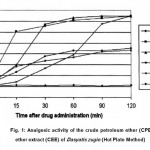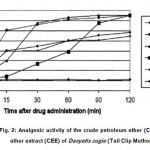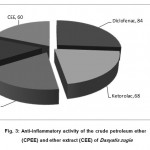Manuscript accepted on : April 15, 2008
Published online on: 01-03-2016
V. Ravitchandirane1 and A. Yogamoorthi2
1Department of Zoology, Centre for Post-Graduate Studies, Puducherry - 605 008 (India) 2Pondicherry University Community College, Pondicherry University, Lawspet, Puducherry - 605 008 (India)
ABSTRACT: Dasyatis zugei (Muller and Henle (1841), the pale-deged sting ray its traditionally used by freshermen community of Puducherry for the treatment of various body ailments. Presently an attempt was made to examine the analgesic and anti-inflammatory properties of crude extract of commonly available ray fish, Dasyatis zugei using mouse assay. The statistically tested data from this experimental study, revealed that the crude petroleum ether and ether extracts of the ray fish exhibited significant pharmacological activities further it was also noticed that, of the extracts ether extract showed higher level of analgesic and anti-inflammatory property in comparison with standard drugs.
KEYWORDS: Sting ray; analgesic; anti-inflammatory; mouse assay
Download this article as:| Copy the following to cite this article: Ravitchandirane V, Yogamoorthi A. Studies on the analgesic and anti-inflammatory properties of crude extracts of sting ray, Dasyatis zugei (Muller and Henle 1841). Biosci Biotechnol Res Asia 2008;5(1) |
| Copy the following to cite this URL: Ravitchandirane V, Yogamoorthi A. Studies on the analgesic and anti-inflammatory properties of crude extracts of sting ray, Dasyatis zugei (Muller and Henle 1841). Biosci Biotechnol Res Asia 2008;5(1). Available from: https://www.biotech-asia.org/?p=6846 |
Introduction
According to the World Health Organization, approximately 80% of the population of developing countries use traditional medicines (Allison Perry, 1996). Traditional healing practices are as old as the advent of man and are highly varied, because it is ethnic, community specific and eco-system specific. The traditional knowledge regarding the medicinal value of the fishes is prevalent among the local communities.
Dasyatis zugei (Muller & Henle, 1841), commonly known as pale-edged sting ray is being traditionally used by fisherman community of Puducherry for the treatment of various body ailments. The present work is a pharmacological evaluation of the crude petroleum ether and solvent ether fraction of the whole fish extract in mice and rats using various analgesic and anti-inflammatory model in order to justify the traditional knowledge.
Material and Methods
Extraction and fractionation (Clarke, 1969)
About 300g of freshly collected whole fish was homogenized and refluxed thrice with hot methanol for 4-6h. The combined methanol extract was filtered and centrifuged at 10,000 rpm for 10 minutes. Resulting supernatant was concentrated in vaccum evaporator. The residue obtained was then fractionated successively with petroleum ether (60°-80°C) and solvent ether, the yield of each extract was about 7.5%. The crude extract obtained in each case was suspended in 2% gum acacia and used for pharmacological evaluation.
Animals
Male albino rats (150-170g) and male swiss mice (15-30g) were procured from King Institute of Preventive Medicine, Guindy, Chennai used in the experiment. Animals were maintained at room temperature and fed on pellet diet and water ad libitum. All the test doses were administered intra peritonealy (i.p) which are 10 times lower than LD50 dose.
Assessment of analgesic activity
Hot plate method
The analgesic activity was assessed by hot plate (thermal) method as described by Eddy and Leimbach (1953). The mice were divided into six experimental groups of six animals each Group 1 served as control received normal saline (2ml/kg), Group 2, 3 and 4 were treated with standard drugs (reference) buprenorphine (5mg/kg), pethidine (30mg/kg) and pentazocine (5mg/kg) respectively. Group 5 and 6 were administered crude petroleum ether extract (80mg/kg) and ether extract (95mg/kg). The animals were placed on a hot plate (Analgesiometer, Techno) maintained at a temperature of 55 ± 0.5°C. The basal reaction time, when the animals licked their paw or jumping occurred was recorded by a stop watch before (0) and 15, 30, 60, 90 and 120min after administration of crude extracts. A cut off time of 15sec was used. The increase in reaction time against control was calculated.
Haffner’s tail clip method
Haffner’s tail clip method was performed as described by Bartoszyk and Wild (1989), Group 1 to 6 received the control, standard drugs (reference) and test extracts as in hot plate method. Artery clip with thin rubber sleeves was applied at the base of the animal tail. The time taken by the animal to make an effort to dislodge the clip was recorded before (0) and at 15, 30, 60, 90 and 120min after administration of crude extracts. The increase in reaction time against control was recorded.
Assessment of anti-inflammatory activity
Carrageenan-induced rat paw oedema
The carrageenan-induced paw edema assay was carried out in male albino rat (150-170g) described by Winter et al., (1962). Edema was induced by sub-planter injection of 0.1ml of freshly prepared 1% carrageenan (w/v) into the right hind paw of the rats of six groups of six animals each. Group 1 served as carrageenan control (0.1ml/kg), Group 2, 3 and 4 were treated with standard drugs (reference) diclofenac sodium (10mg/kg), ketorolac (10mg/kg) and phenylbutazone (200mg/kg) respectively. Group 5 and 6 were given petroleum ether (80mg/kg) and ether extract (95mg/kg) of Dasyatis zugei. The volume of pedal edema was measured at 0 and 1/2, 1, 2, 3 and 4h after injection of carrageenan using a plethysmometer (Ugo Basile). All the treatment was given 30min prior to the injection of carrageenan. The percentage of edema inhibition was calculated for each animal group.
Statistical analysis
The analysis of variance, ANOVA followed by Fisher test were used for statistical analysis. Data were expressed as mean ± SEM. A probability value (P < 0.05) was considered as significant. A graphical representation of the data is also done.
Results
The analgesic activity was assessed in two different models; the hot plate and tail clip in mice. The results (mean ± SEM) of hot plate method showed that the crude petroleum ether and ether extract exhibited increase in basal reaction time from 2.333 ± 0.092 and 2.400 ± 0.058 at 0 min to 8.700 ± 0.026 and 9.067 ± 0.033 at 120min respectively (Fig. 1). The tail clip method revealed a well marked increase in basal reaction time of 10.967 ± 0.056 in petroleum ether and 11.683 ± 0.065 in ether extract at 120 min (Fig. 2). The basal reaction time of control groups were 2.233 ± 0.061 and 2.667 ± 0.033 in hot plate and tail clip models respectively, where as the standard drugs (reference) buprenorphine, pethidine and pentazocine showed maximum reaction time of 15.00 ± 0.000 in both the models at 120min.
 |
Figure 1: Analgesic activity of the crude petroleum ether (CPEE) and ether extract (CEE) of Dasyatis zugie (Hot Plate Method).
|
 |
Figure 2: Analgesic activity of the crude petroleum ether (CPEE) and ether extract (CEE) of Dasyatis zugie (Tail Clip Method).
|
The results of the inhibitory effect of fish extracts on carrageenan induced rat paw edema are shown in Fig. 3. The crude petroleum ether inhibited the edema volume of 45% with a mean edema volume of 3.467 ± 0.033 at 4h, where as the crude ether extract produced to the extent of 60% inhibition of edema volume with a mean 3.233 ± 0.021 at 4h. The carrageenan control induced inflammation with a mean edema volume from 2.500 ± 0.026 at 0 h to 4.000 ± 0.026 at 4h (Fig. 3). The standard drug (reference) diclofenac sodium, ketorolac and phenylbutazone showed inhibition of edema volume of 84%, 68% and 60% respectively (Fig. 3).
 |
Figure 3: Anti-inflammatory activity of the crude petroleum ether (CPEE) and ether extract (CEE) of Dasyatis zugie.
|
Discussion
The methods used for the screening of fish extracts for its analgesic activity are non-specific and it is widely used for analgesic screening, based on the enhancement of pain threshold by the compounds present in the crude extracts. In the present study the petroleum ether and ether extract of Dasyatis zugei were found to be effective as an analgesic since they significantly (P < 0.05) enhance the basal reaction time (Fig.1 and 2). The standard drugs used viz. buprenorphine, pethidine (a lipophilic opioid µ receptor agonist) and pentazocine (a k- receptor agonist) were used in the present study exerted a significant analgesic effect in all pain models by preventing the sensitization of the opioid receptors. As nature of the fish extract was more lipophilic and the probable mechanism of action may be the combination with opioid receptors which enhanced the pain threshold (Gupta et al., 1991) or due to the potentiation of naturally occurring endogenous opioids like enkephalins and endorphins which also involved in natural pain resistant mechanisms (Gerhard vogel and Vogel, 1997; Gutstein and Huda Akil, 2001) These peptides function as synoptic transmitter and bind to opiote receptors and there by produce analgesia.
Carrageenin induced rat paw edema model is a widely used acute inflammatory model to evaluate the anti-inflammatory activity of any given drug because the relationship of inflammatory response to various inflammatory mediators were well established. The ether extract caused a significant inhibition of 60% as effective as the reference drug phenylbutazone (60%), where as the petroleum ether extract showed 49% reduction in edema volume. Carrageenan induced inflammation involves 3 distinct phases. Histamine and serotonin are released in the first phase, kinins may play a role in the second phase (Di Rosa and Sorrentino, 1968) and a more pronounced phase is related to the release of the most important mediator prostaglandins in the final 3-4 h (Vinegar et al., 1969). The arachidonic acid derived from the dietary linoleic acid by the action of phospholipase A2 (PLA2) then metabolished to prostaglandin (PG) by the enzyme cyclo-oxygenase (COX) which is responsible for inflammation (Lin et al., 1992; Jackson Robert II and Morrow, 2001). The standard drugs used in the present study are the most widely used drugs for the treatment of inflammatory conditions (Vane et al., 1998) and are non-selective direct inhibitors of cyclo- oxygenase (COX) affecting both isoforms of COX enzyme, COX-1 and COX-2 (Akiko Tanaka et al., 2002). Our result shows that both the extract caused a significant inhibition in rat paw edema only during the 3 and 4h, where as the inhibition caused at the end of 1 and 2h was not significant, suggesting the probable mechanism of anti-inflammatory action of crude fish extracts may be due to the inhibition of prostaglandin biosynthesis at the point of injury by interfering the cyclo-oxygenase pathway (Fontenele et al., 1996).
To conclude, though both type of extracts showed significant analgesic and anti-inflammatory properties, the ether extract showed higher level of activity that supports the traditional therapeutic practice of suilng these rays fishes for such pharmacological properties among the fisherman community. However further detailed studies are required to identify the exact active principles (s) responsible for such pharmacological properties and their pharmacodynamics.
References
- Akiko Tanaka, Shoko Hase, Tohru Miyazawa, Koji Takeuchi., Up-Regulation of cyclo oxygenase-2 by inhibition of cyclo-oxygenase-1. A key to nonsteroidal anti-inflammatory drug induced intestinal damage. J Pharmacol exp Ther 300: 754-761 (2002).
- Allison Perry., Global survey of marine and estuarine species used for traditional medicines and/or tonic foods. WHO report, McGill University, Quebee, Canada
(1966). - Bartoszyk GD, Wild A., B-vitamins potentiate the antinociceptive effect of diclofenac in carrageenin-induced hyperalgesia in the rat tail pressure test. Neurosci Lett 101: 95-100 (1989).
- Clarke EGC., Extraction methods in toxicology. In: Isolation and Identification of Drugs. The Pharmaceutical Society of Great Britain, London. 16-30 (1969).
- DiRosa M, Sorrentino L., The mechanism of the inflammatory effect of carrageenan. Euro J Pharmacol 4: 340-342 (1968).
- Eddy NB, Leimbach D., Synthetic analgesics; II Dithienyl butenyl and dithenylbutylamines. J Pharmacol Exp. Ther 107: 385-393
(1953). - Fontenele JB, Viana GSB, Xavier-Filho J, Alencar JW., Anti-inflammatory and analgesic activity of water-soluble fraction from shark cartilage. Braz J Med and Biol Res 29: 643-646 (1996).
- Gerhard Vogel H, Wolfing H. Vogel Anti-inflammatory activity. In: Drug Discovery and Evaluation. Germany, Springer-Verlag Berlin Heidelberg, 390 (1997):.
- Gupta YK, Chugh A, Arora S, Seth SD: Modulation of morphine induced antinociception by intracerebroventricularly administered captopril. Indian J Exp Biol 29: 543-545 (1991).
- Gutstein HB, Huda Akil: Opioid analgesics. In: Goodman and Gilman’s The pharmacological basis of therapeutics, Tenth ed. New York, McGraw Hill Medical Publishing Division, 569-619 (2001).
- Jackson Roberts II. Morrow JD: Analgesic-Antipyretic and anti-inflammatory agents and drugs employed in the treatment of gout. In: Goodman and Gilman’s The pharmacological basis of therapeutics, Tenth ed. New York, McGraw-Hill Medical publishing division, 687-731 (2001).
- Lin LL, Lin AJ, Knopf JL Cytosolic phospholipase A2is coupled to hormonally regulated release of arachidonic acid. Proc Natl Aca Sci 89: 6147-6151 (1992).
- Vane JR, Bakhle YS, Bottings RM: Cyclo-oxygenases 1 and 2. Annu Rev Pharmacol Toxicol 38: 97-120 (1998).
- Vinegar R, Schreiber W, Hugo R., Biphasic development of carrageenan edema in rats. J Pharmacol Exp Ther 166: 96-103
(1969). - Winter CA, Risley EA, Nass GW., Carrageenan induced edema in hind paw of rat as an assay for anti-inflammatory drugs. Proc Soc Exp Biol Med 11: 544-547
(1962).

This work is licensed under a Creative Commons Attribution 4.0 International License.





